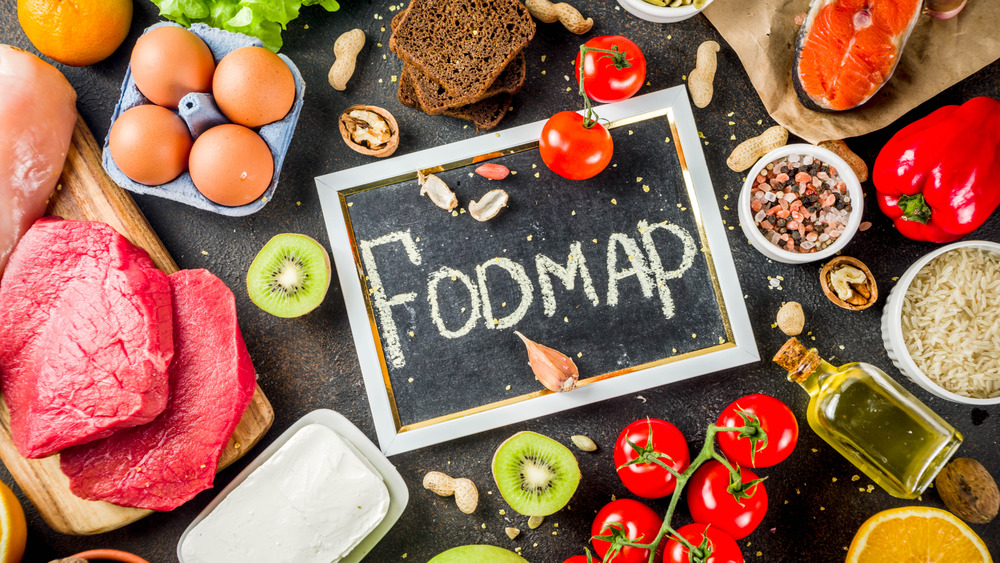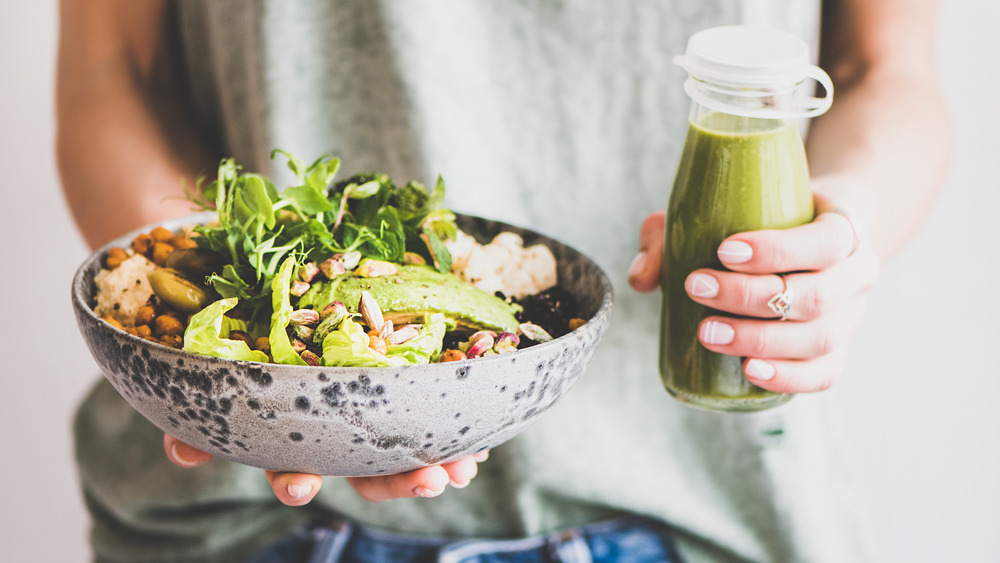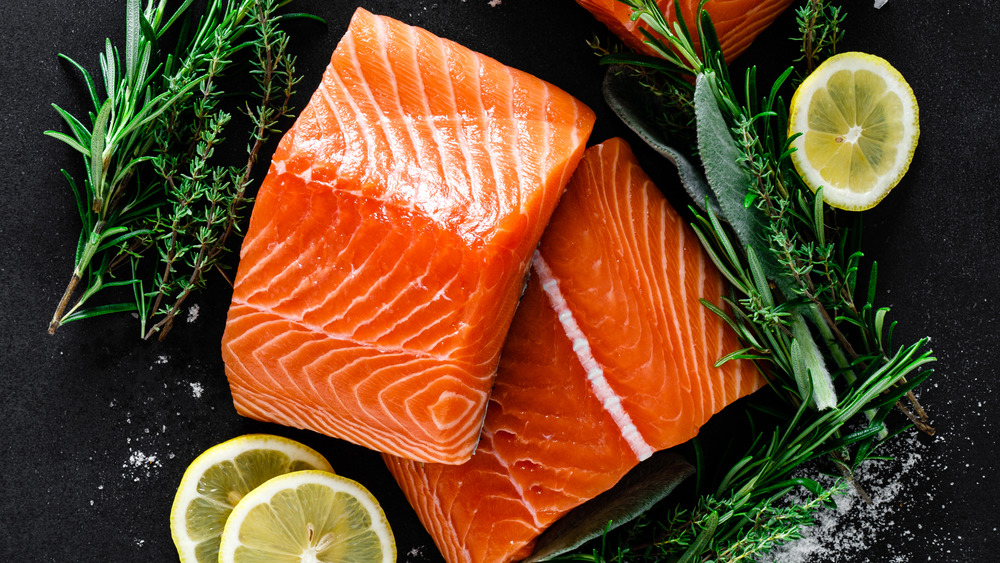The Truth About The Low-FODMAP Diet
The low-FODMAP diet is not exactly new. Celebrities Tyra Banks and Kirsten Dunst have spoken about following the diet in the past, and there's plenty of information out there about the style of eating, what it might do, and how to follow it (via Glamour UK). Proponents of the diet claim it can do everything from eliminating bloat to controlling the symptoms of irritable bowel syndrome.
While you've likely heard of the low-FODMAP diet, you may not know all the details. Despite it being trendy among some celebrities, it's really not meant for most people. In fact, a low-FODMAP diet eliminates many important nutrients, and following it for too long can have serious health consequences, according to Healthline.
Curious to know if you're one of the ones who should try this eating plan? Let's get into the truth about the low-FODMAP diet, who should actually try it, and whether or not the claims floating around about it are actually true.
What even are FODMAPs?
Following a low-FODMAP diet is difficult when you're not quite sure what a FODMAP even is, right? FODMAP is an acronym that stands for fermentable oligosaccharides, disaccharides, monosaccharides, and polyols, according to MedicineNet. They are short-chain carbohydrates and sugar alcohols that don't absorb very well in our bodies. Instead of being broken down and absorbed into the bloodstream, FODMAPs ferment in our large intestine. While this fermentation happens, water is drawn into the intestine and carbon dioxide is released. Some people are particularly sensitive to FODMAPs while others are not. As such, some people might experience serious bloating or intense abdominal pain after eating certain FODMAPs, while others do not (via MedicineNet).
While certain FODMAPs, like sugar alcohols, are food additives, others occur naturally. What's more, these naturally occurring FODMAPs are found in highly nutritious foods like certain fruits and vegetables, beans, lentils, wheat, and dairy products. In fact, some FODMAPs are prebiotic fibers that feed healthy probiotic bacterias in our gut, so FODMAPs have health benefits for people who can tolerate them without serious digestive symptoms, MedicineNet explained.
Some people experience these symptoms after eating FODMAPs
Because FODMAPs are short-chain carbohydrates that ferment in the large intestine instead of being broken down and absorbed, some people experience some pretty gnarly symptoms after eating them. These symptoms include cramping, diarrhea, constipation, stomach bloating, and gas, Johns Hopkins Medicine explained.
In some people, even small amounts of a certain FODMAP-containing food can lead to these uncomfortable symptoms. In other people, symptoms may only occur after eating large amounts. And, because people with irritable bowel syndrome (IBS) or small intestinal bacterial overgrowth (SIBO) are more prone to digestive issues — in fact, digestive issues are a characteristic of these conditions — FODMAPs are more likely to be a problem (via Johns Hopkins Medicine).
Unfortunately, there is no known medication that effectively and consistently treats the symptoms of consuming FODMAPs. Instead, people who experience these symptoms intensely or frequently might try a low-FODMAP diet to figure out which foods trigger their symptoms.
FODMAPs are in so many common foods
The low-FODMAP diet is all about elimination. Essentially, you eliminate all foods that contain FODMAPs, or short-chain carbohydrates that ferment in your gut instead of breaking down. Unfortunately, so many common and nutritious foods contain FODMAPs.
Some vegetables that you cannot eat on a low-FODMAP diet include onions, garlic, cabbage, broccoli, cauliflower, snow peas, asparagus, artichokes, leeks, beets, celery, corn, Brussels sprouts, and mushrooms. When it comes to fruits, you'll need to avoid peaches, apricots, nectarines, plums, prunes, mangoes, apples, pears, watermelon, cherries, and blackberries, as well as dried fruits and fruit juices from concentrates. Legumes, like beans and lentils, are also off the table, as are pastas, wheat, most dairy products, sugars, and most artificial sweeteners, and alcohol (via MedicineNet).
Obviously, this is a tough diet to follow. What's more, cutting out so many nutritious foods can make it tough to get enough calories and nutrients. Typically, the low-FODMAP diet calls for eliminating these foods for anywhere from three to eight weeks. Any longer than that may not be safe.
You can eat plenty of fat and protein on a low-FODMAP diet
It's possible to eat plenty of fat and protein on a low-FODMAP diet. Dairy, beans, legumes, and certain nuts — good sources of healthy fats and/or protein — are off-limits because they also contain carbs. However, animal protein, lactose-free dairy, and most nuts and seeds are totally fair game, according to MedicineNet.
There are also plenty of other foods you can eat on a low-FODMAP diet, including veggies like bell peppers, carrots, green beans, bok choy, cucumber, lettuce, tomato, zucchini, eggplant, ginger, chives, olives, parsnips, potatoes, and turnips. Feel free to indulge in fruits like oranges, grapes, melon, banana, blueberries, grapefruit, kiwi, lemon, lime, oranges, and strawberries. Plus, you can have lactose-free dairy, non-dairy milks, hard cheeses, beef, pork, chicken, fish, eggs, soy products, rice, oats, quinoa, peanuts, pine nuts, walnuts, and pumpkin seeds, among other foods (via MedicineNet).
However, it's important to note that some of these foods do contain small amounts of FODMAPs (because most foods do!), and that eating too much of them could still cause symptoms.
The low-FODMAP diet is an elimination diet meant to suss out food sensitivities
The low-FODMAP diet is a short-term elimination diet meant to identify food sensitivities. It's not a diet that you're meant to follow long term, nor is it one for weight loss. "The low FODMAP diet is a temporary eating plan that's very restrictive," gastroenterologist Hazel Galon Veloso told Johns Hopkins Medicine. She reiterated that it's important to discuss any new diet with your doctor, but especially the low-FODMAP diet due to its highly restrictive nature.
This diet can be particularly harmful for people who are underweight or who have certain chronic conditions. Also, anyone with an eating disorder or an eating disorder history should absolutely not try the low-FODMAP diet. The National Eating Disorders Association (NEDA) warns against any kind of restrictive diet, because it can trigger or exacerbate an eating disorder.
If you are struggling with an eating disorder, or know someone who is, help is available. Visit the National Eating Disorders Association (NEDA) website or contact NEDA's Live Helpline at 1-800-931-2237. You can also receive 24/7 Crisis Support via text (text NEDA to 741741).
There are three steps to a low-FODMAP diet
The low-FODMAP diet has only three steps. First, elimination. You cut out all foods that contain FODMAPs for a set period of time. "We recommend following the elimination portion of the diet for only two to six weeks," gastroenterologist Hazel Galon Veloso told Johns Hopkins Medicine. "This reduces your symptoms and if you have SIBO [small intestinal bacterial overgrowth], it can help decrease abnormally high levels of intestinal bacteria."
The next step is reintroduction. Veloso recommends that her patients reintroduce one high-FODMAP food back into their diet every three days, one at a time. This way, they're able to see which foods cause symptoms and which do not. It's important to do this under the guidance of a doctor or registered dietitian who can help you properly identify symptoms and triggers.
The final step happens once you've identified which foods trigger symptoms, if any. Once you've identified those trigger foods, you can resume eating other FODMAP-containing foods, free of worry, while limiting or avoiding the ones that trigger symptoms.
A low-FODMAP diet might improve quality of life for people with irritable bowel syndrome
If you have irritable bowel syndrome (IBS), you've probably tried various ways to manage your symptoms and been frustrated by the lackluster results. Unfortunately, there's a lot we don't yet understand about IBS, and how to best manage the condition may vary from person to person, the Mayo Clinic explained. Even getting a diagnosis can be a long and frustrating process.
For some people with IBS, a low-FODMAP diet could be extremely helpful for managing symptoms. According to a 2016 systematic review of existing studies published in the European Journal of Nutrition, eating a diet low in FODMAP-containing foods might help alleviate uncomfortable IBS symptoms like gas, bloating, diarrhea, constipation, and stomach pain. However, the study authors concluded that more research needs to be done to determine how a low-FODMAP diet affects IBS symptoms over the long term.
A low-FODMAP diet can't solve all digestive problems
A low-FODMAP diet isn't a cure-all for digestive issues. The only people who might benefit from a low-FODMAP diet are people who are, naturally, sensitive to certain FODMAPs. Sure, you may have to try a medically supervised low-FODMAP diet in order to figure out whether you're sensitive to certain FODMAPs, but it's important to keep in mind that the diet probably won't solve all of your digestive issues (via Healthline).
Experts suggest considering a low-FODMAP diet if you have ongoing digestive symptoms like gas, bloating, abdominal pain, constipation, or diarrhea that won't go away. But before you try a low-FODMAP diet, there are other interventions that experts recommend. First, try stress management, as stress can make symptoms worse. Then, try less restrictive dietary interventions like avoiding or limiting alcohol, caffeine, and spicy foods, according to Healthline.
In other words, a low-FODMAP diet should be one of the last things you try. It's hard to follow, and it's very limiting in terms of getting all the nutrients you need.
People who are not sensitive to FODMAPs should not follow a low-FODMAP diet
This bears repeating: People who are not sensitive to FODMAPs should not follow a low-FODMAP diet. According to Harvard Health Blog, there are a lot of potential negative side effects that come with the low-FODMAP diet.
For starters, following the low-FODMAP diet, even short term, sometimes makes it hard to reintroduce certain foods afterwards. "Some people become hesitant to reintroduce items, especially if they have experienced significant symptom relief during the elimination phase," wrote dietitian Emily Gelsomin for Harvard.
A long-term low-FODMAP diet might change the bacterial environment of your gut and actually worsen any digestive symptoms over time, Gelsomin wrote. Why? Because FODMAPs feed healthy gut bacteria known as probiotics. Without any FODMAPs, your gut may over time have less of these healthy probiotic bacteria. This could make it easier for potentially harmful microbes to enter and multiply in your gut, which would make your digestive symptoms worse and lead to more inflammation.
A low-FODMAP diet can lead to nutrient deficiencies
Following a low-FODMAP diet for more than a few weeks can lead to an increased risk of certain nutrient deficiencies. "For example, it's common for people avoiding dairy to have inadequate calcium intake," wrote dietitian Emily Gelsomin in an article for Harvard Health Blog. She added that magnesium deficiency is another concern, since a low-FODMAP diet cuts out high-magnesium foods like beans, almonds, and cashews.
Not to mention, eliminating various fruits and vegetables could put you at risk for all kinds of vitamin deficiencies, since these foods are great sources of several important vitamins. The 2015-2020 Dietary Guidelines for Americans recommends that you get at least five servings of fruits and vegetables each day. Fruits, according to the guidelines, are a major source of fiber, potassium, and vitamin C in our diet. Similarly, vegetables are a major source of so many micronutrients, including B vitamins, selenium, choline, phosphorus, zinc, copper, vitamin D, and vitamin E.
It's recommended that you eat a variety of fruits and vegetables in order to get the most out of the various nutrients they contain, but a low-FODMAP diet makes this difficult.
You may consider cutting back on low-FODMAP foods instead of eliminating them altogether
A low-FODMAP diet can make it practically impossible to eat the type of overall healthy diet that experts recommend. According to the 2015-2020 Dietary Guidelines for Americans, a healthy diet is made up of fruits, vegetables, grains (particularly whole grains), beans, legumes, nuts, seeds, low-fat dairy, healthy fats, and lean proteins.
While protein and healthy fats are allowed pretty much without restriction on the low-FODMAP diet, there are many, many rules about which fruits, vegetables, nuts, seeds, grains, and dairy products you can and cannot eat. However, according to Harvard Health Blog, some people may be able to get the potential benefits of a low-FODMAP diet (decreased digestive symptoms like gas, bloating, abdominal pain, diarrhea, and constipation) without cutting out nutritious foods altogether.
"Simply cutting back on high-FODMAP foods in your diet, without entirely eliminating any food groups, may be an alternative," dietitian Emily Gelsomin explained in the Harvard article. She continued, writing, "If your diet contains many common offenders like garlic, onions, beans, apples, milk, mushrooms, and wheat, a simple reduction may help decrease symptoms."
A long-term low-FODMAP diet that works for one person may not work for you
So if the low-FODMAP diet is a short-term solution to digestive issues, what is the long-term solution? According to WebMD, people who find relief on a low-FODMAP diet will follow a personalized and much less restrictive diet in the long-term. Much of what the person can eat comes from trial and error, eliminating the FODMAP-containing foods that cause symptoms. However, this does not mean that all high-FODMAP foods are off the table. When high-FODMAP foods are introduced without negative symptoms, they can be added back to a person's diet (via WebMD).
For one person, that might mean avoiding onions but eating every other vegetable. For another, traditional dairy products may cause digestive symptoms but lactose-free dairy proves to be a viable solution. While on a low-FODMAP diet, it's also entirely possible that you learn that FODMAPs aren't what cause your symptoms, and it's fine to eat them without restriction.
It's important to reintroduce as many foods as possible while on a low-FODMAP diet. By personalizing the diet this way, you'll be able to eat most foods without overthinking or feeling deprived, and avoid only the few that really do cause you digestive issues.
If you don't have symptoms of IBS, don't try the low-FODMAP diet
A low-FODMAP diet is difficult to follow. The list of foods to eliminate is extremely long, and you'll probably have to reference it often. Because FODMAPs show up in some foods but not other similar foods, it isn't as cut and dried as eliminating an entire food group (not that this is a healthy approach, either).
"This is a learning diet that helps people with IBS [irritable bowel syndrome] identify their triggers," dietitian Kate Scarlata told Eating Well. "It is not a fad diet for weight loss — it is prescribed as a form of medical nutrition therapy. If you don't have IBS symptoms, the low FODMAP diet is not for you."
As Healthline explained, "Unless you have been diagnosed with IBS, research suggests the diet could do more harm than good." Plus, even if you do have IBS, you shouldn't stay on the highly restrictive plan for very long. Instead, you'll want to incorporate more and more foods into your diet as you can handle them.
You should talk to a doctor or dietitian before trying a low-FODMAP diet
Considering the idea of a low-FODMAP diet is to figure out which foods trigger uncomfortable digestive systems and which foods do not, it's important that you work closely with a qualified doctor or dietitian.
Registered dietitian Kate Scarlata, who specializes in the management of irritable bowel syndrome (IBS), recommended on her site that you talk to your doctor about any gastrointestinal discomfort you feel. You may be referred to a gastroenterologist, a doctor who specializes in this area. Scarlata further advised finding a gastroenterologist that you feel comfortable talking to, and being very clear with them about which symptoms you experience, when they occur, and how severe they are.
Your gastroenterologist may (or may not) recommend low-FODMAP diet if other treatments don't work for you. More than likely, you'll also be advised to see a dietitian who can guide you through the elimination, reintroduction, and personalization phases of a low-FODMAP diet.















